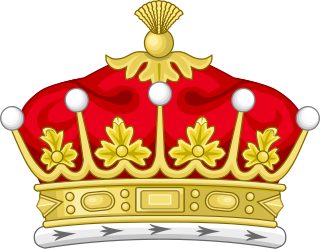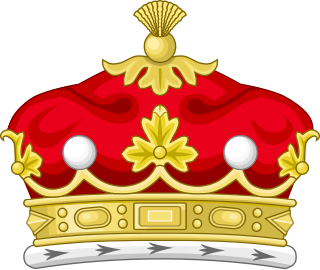 W
WEarl Cadogan is a title that has been created twice in the Peerage of Great Britain for the Cadogan family. The second creation, in 1800, was for Charles Cadogan, 3rd Baron Cadogan.
 W
WThe title Earl Castleton, of Sandbeck in the County of York, was created in the Peerage of Great Britain in 1720 for the 6th Viscount Castleton, who had previously been created Baron Saunderson, of Saxby in the County of Lincoln, in 1714, and Viscount Castleton, of Sandbeck in the County of York, in 1716, both also in the Peerage of Great Britain.
 W
WEarl Coningsby was a title in the Peerage of Great Britain. It was created in 1719 for Thomas Coningsby, 1st Baron Coningsby, with remainder to his eldest daughter, Margaret Newton, 1st Viscountess Coningsby, and the heirs male of her body. He was the great-grandson of the soldier and politician Sir Thomas Coningsby. Coningsby had already been created Baron Coningsby, of Clanbrassil, in the Peerage of Ireland in 1693, with normal remainder to heirs male, and Baron Coningsby in the Peerage of Great Britain in 1716, with similar remainder as for the earldom. On Lord Coningsby's death in 1729 he was succeeded in the Irish barony of 1692 by his grandson Richard Coningsby, the second Baron, the son of one of Coningsby's sons from his first marriage to Barbara Georges. However, Richard died already the same year, when the barony became extinct. Lord Coningsby was succeeded in the English barony and the earldom according to the special remainder by his daughter Margaret Newton, 1st Viscountess Coningsby. She had already in 1716 been made Baroness Coningsby, of Hampton Court in the County of Hereford, and Viscountess Coningsby in her own right. Both titles were in the Peerage of Great Britain. Lady Coningsby was the wife of Sir Michael Newton, 4th Baronet, of Barrs Court and Culverthorpe Hall, Lincolnshire. She had no surviving male issue and the titles became extinct on her death in 1759.
 W
WEarl Coningsby was a title in the Peerage of Great Britain. It was created in 1719 for Thomas Coningsby, 1st Baron Coningsby, with remainder to his eldest daughter, Margaret Newton, 1st Viscountess Coningsby, and the heirs male of her body. He was the great-grandson of the soldier and politician Sir Thomas Coningsby. Coningsby had already been created Baron Coningsby, of Clanbrassil, in the Peerage of Ireland in 1693, with normal remainder to heirs male, and Baron Coningsby in the Peerage of Great Britain in 1716, with similar remainder as for the earldom. On Lord Coningsby's death in 1729 he was succeeded in the Irish barony of 1692 by his grandson Richard Coningsby, the second Baron, the son of one of Coningsby's sons from his first marriage to Barbara Georges. However, Richard died already the same year, when the barony became extinct. Lord Coningsby was succeeded in the English barony and the earldom according to the special remainder by his daughter Margaret Newton, 1st Viscountess Coningsby. She had already in 1716 been made Baroness Coningsby, of Hampton Court in the County of Hereford, and Viscountess Coningsby in her own right. Both titles were in the Peerage of Great Britain. Lady Coningsby was the wife of Sir Michael Newton, 4th Baronet, of Barrs Court and Culverthorpe Hall, Lincolnshire. She had no surviving male issue and the titles became extinct on her death in 1759.
 W
WEhrengard Melusine von der Schulenburg, Duchess of Kendal, Duchess of Munster was a longtime mistress to King George I of Great Britain.
 W
WEhrengard Melusine von der Schulenburg, Duchess of Kendal, Duchess of Munster was a longtime mistress to King George I of Great Britain.
 W
WEhrengard Melusine von der Schulenburg, Duchess of Kendal, Duchess of Munster was a longtime mistress to King George I of Great Britain.
 W
WEarl Fitzwilliam was a title in both the Peerage of Ireland and the Peerage of Great Britain held by the head of the Fitzwilliam family.
 W
WEarl of the Island of Jersey, usually shortened to Earl of Jersey, is a title in the Peerage of England held by a branch of the Villiers family, which since 1819 has been the Child-Villiers family.
 W
WEarl of Macclesfield is a title that has been created twice. The first creation came in the Peerage of England in 1679 in favour of the soldier and politician Charles Gerard, 1st Baron Gerard. He had already been created Baron Gerard, of Brandon in the County of Suffolk, in 1645, and was made Viscount Brandon, of Brandon in the County of Suffolk, at the same time as he was given the earldom. These titles are also in the Peerage of England. Lord Macclesfield was the great-grandson of the distinguished judge Sir Gilbert Gerard, Master of the Rolls from 1581 to 1594. He was succeeded by his eldest son, the second Earl. He was involved in the Rye House Plot of 1683, was sentenced to death but later pardoned by the King. On his death without legitimate issue in 1701 the titles passed to his younger brother, the third Earl. He had earlier represented Yarmouth, Lancaster and Lancashire in the House of Commons. When he died in 1702 the titles became extinct.
 W
WEhrengard Melusine von der Schulenburg, Duchess of Kendal, Duchess of Munster was a longtime mistress to King George I of Great Britain.
 W
WMarquess of Cholmondeley is a title in the Peerage of the United Kingdom. It was created in 1815 for George Cholmondeley, 4th Earl of Cholmondeley.
 W
WDuke of Northumberland is a noble title that has been created three times in English and British history, twice in the Peerage of England and once in the Peerage of Great Britain. The current holder of this title is Ralph Percy, 12th Duke of Northumberland.
 W
WEarl of Onslow, of Onslow in the County of Shropshire and of Clandon Park in the County of Surrey is a title in the Peerage of the United Kingdom. It was created in 1801 for George Onslow, 4th Baron Onslow. The Onslow family descends from Arthur Onslow, who represented Bramber, Sussex and Guildford in the House of Commons. He was the husband of Mary, daughter of Thomas Foote, Lord Mayor of London in 1649, who had been created a Baronet in 1660. In 1674 Onslow was himself created a Baronet in the Baronetage of England, with the precedence of 1660.
 W
WEarl of Macclesfield is a title that has been created twice. The first creation came in the Peerage of England in 1679 in favour of the soldier and politician Charles Gerard, 1st Baron Gerard. He had already been created Baron Gerard, of Brandon in the County of Suffolk, in 1645, and was made Viscount Brandon, of Brandon in the County of Suffolk, at the same time as he was given the earldom. These titles are also in the Peerage of England. Lord Macclesfield was the great-grandson of the distinguished judge Sir Gilbert Gerard, Master of the Rolls from 1581 to 1594. He was succeeded by his eldest son, the second Earl. He was involved in the Rye House Plot of 1683, was sentenced to death but later pardoned by the King. On his death without legitimate issue in 1701 the titles passed to his younger brother, the third Earl. He had earlier represented Yarmouth, Lancaster and Lancashire in the House of Commons. When he died in 1702 the titles became extinct.
 W
WEarl of Portland is a title that has been created twice in the Peerage of England, firstly in 1633 and secondly in 1689. What proved to be a long co-held title, Duke of Portland, was created in 1716 and became extinct in 1990 upon the death of the ninth Duke, at which point the earldom passed to the most senior agnatic cousin, namely one of the 6th degree.
 W
WEarl of Romney is a title that has been created twice.
 W
WViscount Bolingbroke is a current title in the Peerage of Great Britain created in 1712 for Henry St John. He was simultaneously made Baron St John, of Lydiard Tregoze in the County of Wilts. Since 1751, the titles are merged with the titles of Viscount St John and Baron St John in the same peerage.
 W
WViscount Bolingbroke is a current title in the Peerage of Great Britain created in 1712 for Henry St John. He was simultaneously made Baron St John, of Lydiard Tregoze in the County of Wilts. Since 1751, the titles are merged with the titles of Viscount St John and Baron St John in the same peerage.
 W
WEarl of Portland is a title that has been created twice in the Peerage of England, firstly in 1633 and secondly in 1689. What proved to be a long co-held title, Duke of Portland, was created in 1716 and became extinct in 1990 upon the death of the ninth Duke, at which point the earldom passed to the most senior agnatic cousin, namely one of the 6th degree.
 W
WThomas Newport, 1st Baron Torrington, styled The Honourable from 1675 until 1716, was an English barrister and Whig politician who sat in the English and British House of Commons between 1695 and 1716 when he was raised to the peerage as Baron Torrington.
 W
WThe title of Earl of Ulster has been created six times in the Peerage of Ireland and twice Peerage of the United Kingdom. Since 1928, the title has been held by the Duke of Gloucester and is used as a courtesy title by the Duke's eldest son, currently Alexander Windsor, Earl of Ulster. The wife of the Earl of Ulster is known as the Countess of Ulster. Ulster, one of the four traditional provinces of Ireland, consists of nine counties, six of which make up Northern Ireland, the remainder are in Ireland.
 W
WDuke of York and Albany was a title of nobility in the Peerage of Great Britain. The title was created three times during the 18th century and was usually given to the second son of British monarchs. The predecessor titles in the English and Scottish peerages were Duke of York and Duke of Albany.